Pine Mountain Settlement School
Series 09: Biography – Staff/Personnel
Series 03: Histories
Series 10: Built Environment
Series 14: Medical
WELLS RECORD 12 PMSS Extension Work 1913-1928
TAGS: Wells Record 12 PMSS Extension Work 1913-1928 ; Evelyn K. Wells ; Pine Mountain Settlement School ; Harlan County, KY ; institutional records ; Appalachian settlement schools ; histories ; 1913-1928 ; William Creech ; Katherine Pettit ; Ethel de Long Zande ; Harriet Butler ; Line Fork Settlement ; Medical Settlement Big Laurel ; nurses ; doctors ; rural health ; rural education ; Intermountain Coal and Lumber Company ; Mrs. Emily Hottenstein ; Moonlight Schools ; Anna Wulf Pishzak ; Dr. Grace Huse ; Dr. Ida Stapleton ; Rev. Robert Stapleton ; Anne Ruth Medcalf ; Ruth Dennis ; Helen Dingman ; Oscar Begley
Evelyn K. Wells 12 PMSS Extension Work 1913-1928 was a record of activities at the two satellites operated by Pine Mountain Settlement School. The record details work at the Medical Settlement at Big Laurel and the Line Fork Settlement at Gilley in Letcher County, KY.
WELLS RECORD 12 PMSS Extension Work 1913-1928:
EXTENSION WORK
Our contact with the countryside because so diffuse is hard to measure in its effects. Our extension work may be considered in three parts, — that going out from Pine Mountain itself, the Medical Settlement,[Big Laurel] and Line Fork Settlement.
First of all, then, Pine Mountain. Whenever possible, and in every way, the workers have been helped to get out into the country to visit, contributing in whatever way they were best fitted, to the life of the countryside. Sunday Schools on Little Laurel and at the Divide have been regularly taught, workers with an aptitude for some line of Fireside Industries, and some with nothing but a friendly desire to interest people, have had a day a week for Creekside visiting; Miss Melville in 1917 even tried a “moonlight school” at Big Laurel, discovering some of the faults of that system, but amazed and touched at the spirit of her scholars. Mrs. Emily Hottenstein and other teachers from 1924 to 1928, spent time definitely allotted to them on trips to remote parts of the neighborhood, that they might know the children’s homes and that the school might be better understood in them. These workers brought in proof if we had needed it, that a Pine Mountain worker’s point of view must be constantly corrected by intimate visits in the neighborhood.
Gatherings at Pine Mountain were more frequent in the early days than they are now when practically the only days we see our neighbors at the school are the Fourth of July and the Community Fair. People came for workings, box suppers, Christmas, Sunday preachings at the House in the Woods, parties on Fridays or Saturdays. such gatherings here have grown infrequent for a number of reasons: social life, if we may call the meagre and pitiful neighborhood intercourse by that name, has grown more interesting, with the growth of lumber camps and the improvement in the country schools and in living conditions; people go across the mountain more for their entertainment; our own extension centers provide something more easily attainable; and the life of Pine Mountain has grown so much that perhaps our neighbors do not feel so well acquainted. In the days when neighbors were building and working for us, it seemed more natural for them to come here. Knowing our neighbors through their visits at Pine Mountain was a part of the life of the early days that could still be lost, and we must regret that the growth of the school and the countryside have been away from each other.
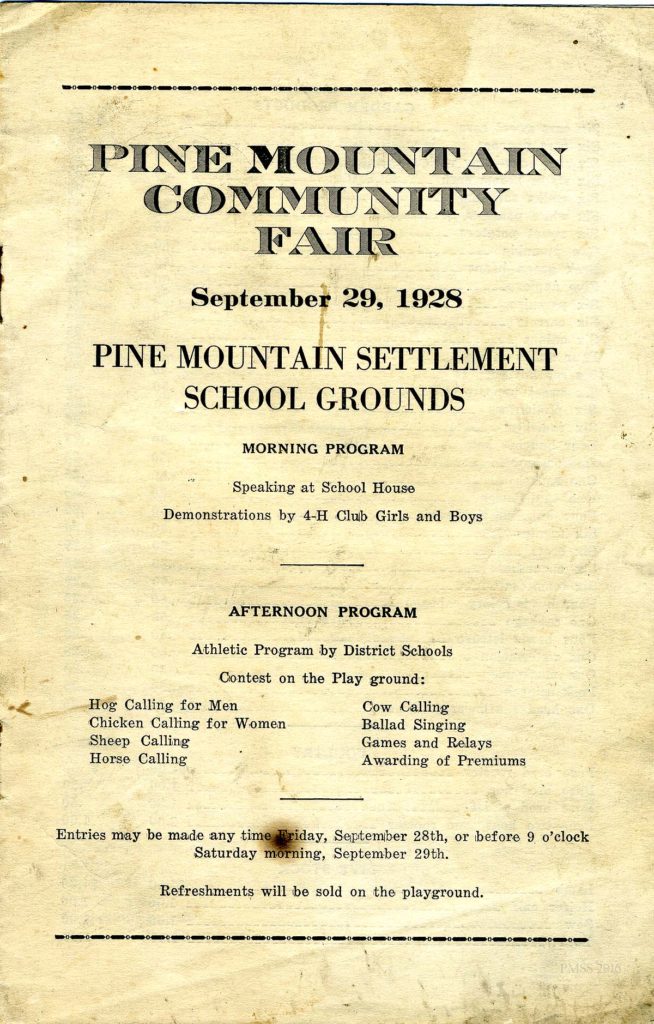
1928 Community Fair Day. Program cover
The Fourth of July and the Community Fair still bring people in great numbers, however. The speakers and the entertainment program of the day, and perhaps most of all, the unusual ice-cream cone, are a great attraction. We are always struck, however, by the fact that nothing on the program gives as much pleasure as the chance they have to visit each other.
During the War, a surprising amount of work went on, considering our remoteness from a situation that was so real to the rest of the country. $850 worth of Liberty Bonds were sold among our neighbors, and this before the day when “public works” on our side of the mountain had made actual cash more available. The women of the neighborhood gathered for knitting and making bandages at the school, on Line Fork, at Aunt Sal’s, at Big Laurel. For a while there was a local branch of the Harlan County Red Cross.
Miss Anna Wulf [Pishzak, in 1926, had a cooking class of little girls from Little Laurel and the Divide Schools, a most successful affair from every point of view.
One of our most interesting ventures into the life of the countryside was the summer Lilliath Robbins spent, in 1919, on Little Laurel. She touched a hollow that had had no district school taught for some years. Her housekeeping and hospitality made a lasting impression on the whole creek, and she made friends for Pine Mountain that have always kept their close, friendly relation. Her experiences are fully described in the Notes [See: Pine Mountain Notes and should be read in connection with this paragraph.]
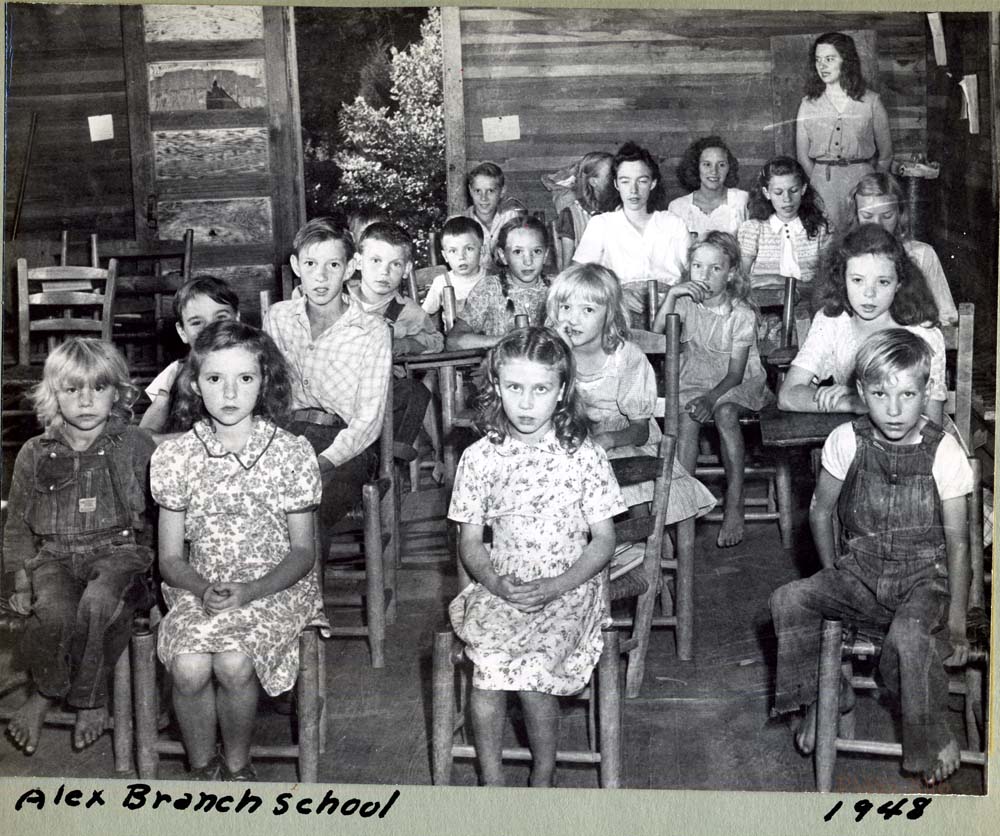
“Alex Branch School, 1948.” Interior of classroom with children, teacher. [nace_II_album_077.jpg]
In 1918, A.C. Jones, the County Superintendent of Schools, asked Mrs. Zande to undertake the supervision of eleven district schools, most of them on this side of Pine Mountain. He was dividing up the county into supervisory sections, with Miss Dingman [Helen Dingman] of Smith in charge of one, and a supervisor at Wallins and another at Poor Fork. For nearly four years Mrs. Zande and Miss Marguerite Butler kept the closest contact with our eleven schools. Miss Butler’s rides to Straight Creek and Beech Fork and Big Laurel and over Pine Mountain to Dillon, as well as her unofficial visits to the Letcher County schools on Line Fork, were of enormous value to the county schools; and the supervisory system did so much good that in 1923, being no longer so necessary, it was discontinued. At this time, too, Miss Dingman, as field worker from Berea, riding out to follow up the work of Berea students in the schools they were teaching, began to cover much of the ground Miss Butler had helped. The effect of this school supervision was very far-reaching; for some years Pine Mountain had the appointing of teachers for the neighboring school’s teachers’ meetings at Pine Mountain took place every fall, and the Line Fork Settlement was started. Miss Butler’s own developing interest in rural education led her to study in Denmark and other countries under a scholarship from the Scandinavian Foundation, with Mrs. John C. Campbell at Brasstown, N.C., as her assistant in the John C. Campbell Folk School.
The Mouth of Little Laurel, very much developed through the lumber operations that went on there in 1924, had no district school provision. Through community effort, supported by Pine Mountain, an old storehouse was fitted up rudely enough, and there for two years the county paid a teacher to work. Finally, a new schoolhouse was built in 1927. Miss Valley Carpenter, from the Eastern Kentucky State Normal School, in the first fall of her work there, stirred the community to so much interest in the project that by a series of box suppers and every other means of raising money, they collected $165.00, which with $100.00 and coal from the County and timber from the old schoolhouse at the Head of Little Laurel where Miss [Lilliath] Robbins had taught the last school in [1919], $100.00 in lumber from the Intermountain Coal and Lumber Company, and the consent of Mr. William Creech to use a piece of his land, was sufficient for the building of the Little Laurel School. This is a very direct indication of what Pine Mountain’s influence, bolstering up local interest, was able to accomplish. For two years there has been a two-months’ subscription school supported by the parents, following the free school.
WELLS RECORD 12 PMSS Extension Work 1913-1928:
THE MEDICAL SETTLEMENT
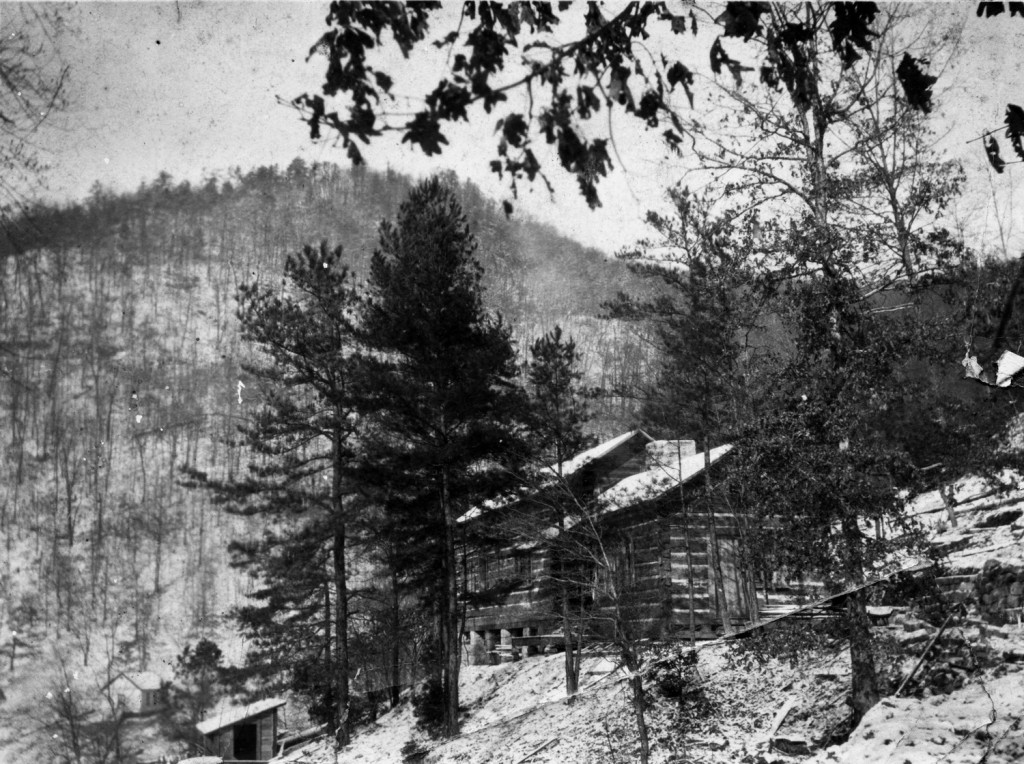
Medical Settlement- Big Laurel. Log cabin on snowy hillside. [big_laurel_3343.jpg]
In 1918 the land at the Mouth of Big Laurel, which in the days before Pine Mountain was started had been considered as a site for the School, was acquired from the Intermountain Coal and Lumber company for a home for a doctor and nurse, and Miss Harriet Butler, for some years the nurse at Hindman, and Miss Pettit’s companion on her first trip to Big Laurel and Pine Mountain in the spring of 1911, came with Dr. Grace Huse to start the work there [in 1918]. The Doctor’s House was built in the summer of 1919, with money given by Mrs. Mary Emery of Cincinnati. Dr. Huse and Miss Butler spent that summer at the Pole House at Pine Mountain, and Mrs. Ethel de Long Zande supervised the building, riding down the creek practically every day to see how Oscar Begley, the local carpenter in charge, progressed. The logs for that house were contributed by the neighborhood and much of the labor. Big Laurel, being even more remote from building supplies than Pine Mountain, was not complete for some time but the family was able to move in before cold weather.
The Medical Settlement family soon added to itself a community worker, and for some years the Big Laurel school teacher had been a member of it. The “Playhouse,” built in 1920, with funds raised largely by Miss Emily Storer, the community worker at the time, gathered in the young people of the neighborhood for all sorts of good times and classes and Sunday School work. It burned down in 1925 and was replaced by the larger and more efficient Community House.
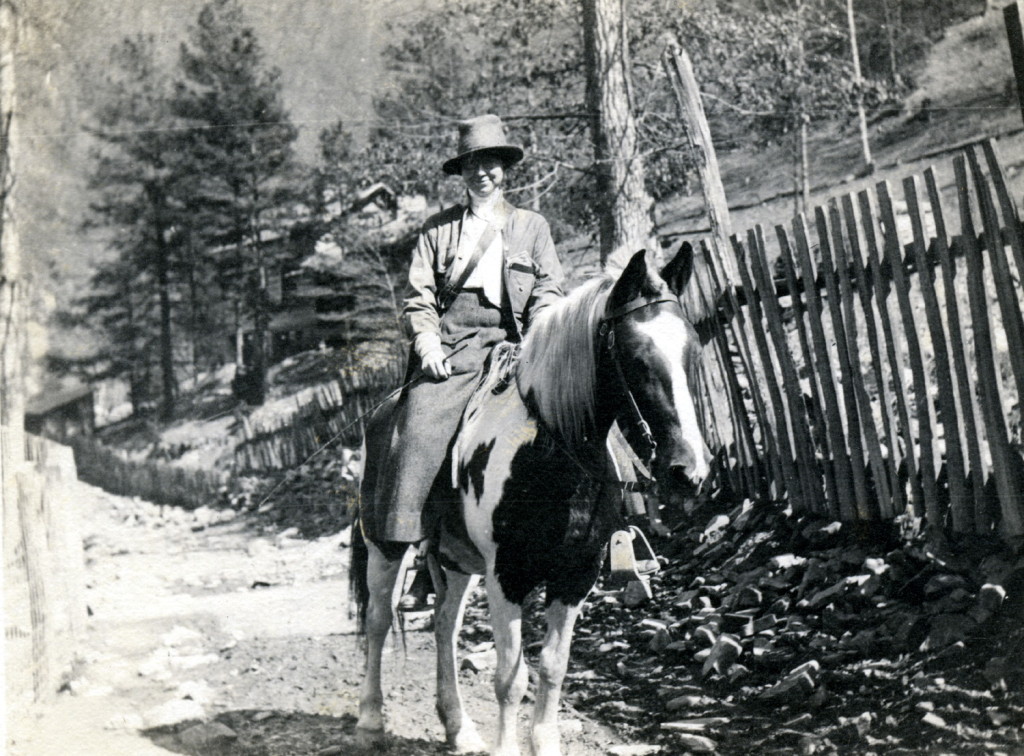
Dr. Huse on horse, “Jim” (?) at Medical Settlement, Big Laurel. [X_099_workers_2514d_mod.jpg]
What the medical and social work at Big Laurel has meant in ten years to the whole countryside cannot possibly be estimated here. Indications of its value in the early days will be found in various paragraphs on the work at Big Laurel in the Notes [Pine Mountain Notes], in changing conditions of sanitation and health, particularly among the children, in the growth of a definite health program at the school, in clinics, etc. In 1924 both Dr. Huse and Miss [Harriet] Butler] found it necessary to give up on the work on account of health, and since then Dr. Alfreda Withington has been the physician. Dr. Withington comments that she is continually impressed with the sound principals on which the work was founded. By this she means chiefly the policy of working the community up to helping themselves more, and of having the Doctor’s House a center of real neighborliness.
WELLS RECORD 12 PMSS Extension Work 1913-1928:
THE LINE FORK SETTLEMENT
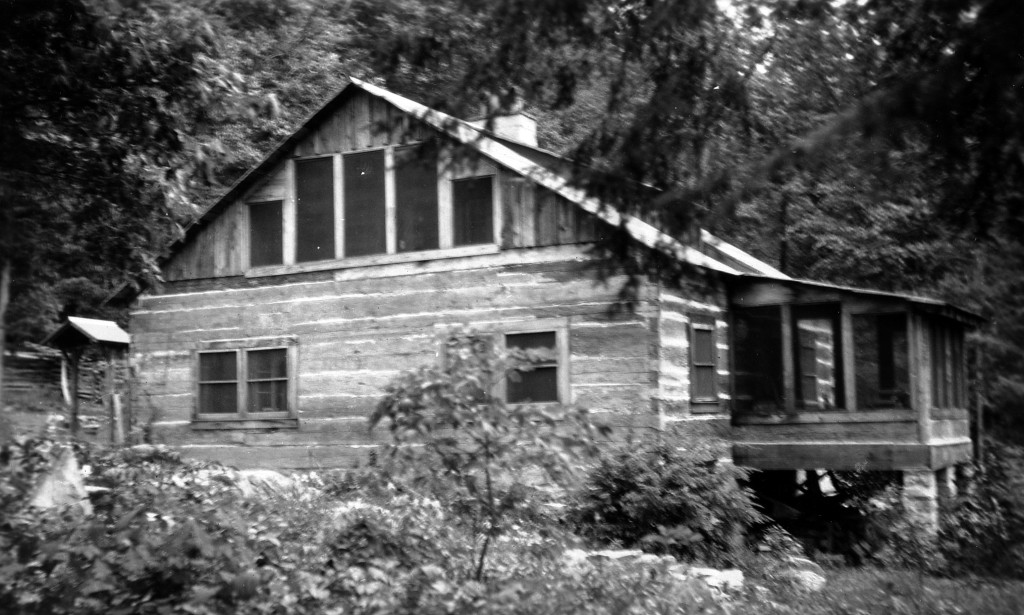
[107_line_fork_006b1.jpg]
This paragraph aims only at broad outlines, but Miss [Katherine] Pettit has a full and most interesting account of the early days on Line Fork, which should be read in this connection. [? Source]
In July 1920, Isabella McClennan of Louisville and Martha Van Meter of Lexington went over to Line Fork and taught the Bear Branch School, living in a tiny log house next [to] the School. During the late summer and fall, Miss Marguerite Butler supervise the building of the Settlement Cabin, and that fall came Miss Anne Pavey, a teacher from Chicago, Miss Frances Palmer, a nurse from Minneapolis, and Miss Ruth Dennis of Chicago as the first permanent staff. In 1921 came Miss Anne Ruth Medcalf, a Johns Hopkins nurse, who was head resident for three years. For a while teachers for the Coil Branch and Bear Branch district schools were supplied by Pine Mountain, but since then the county has gotten its own teachers. For this reason partly, the work at Line Fork has not progressed along the same lines as that at Big Laurel, though a comparison of the two Settlements is impossible because of the different underlying economic conditions. Line Fork, like Big Laurel, was fortunate in its early staff and the sound principles on which the work was laid out.
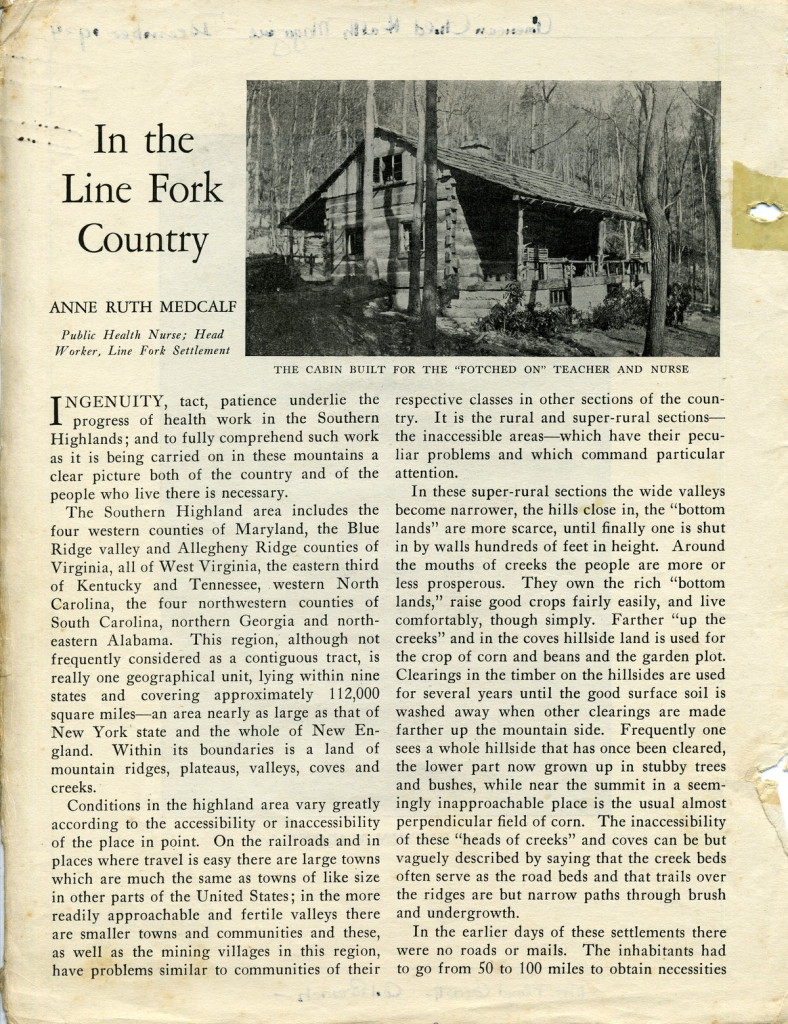
Anne Medcalf – “In the Line Fork Country” American Child Health Magazine, December 1924. p.02
Miss Frances Palmer and, Miss Anne Ruth Medcalf, being the first public health nurses in Letcher county, were partly supported by the State. Public health work in Whitesburg developed later, so our nurses at Line Fork were no longer eligible for this work. Medical work went on under greater difficulties here than at Big Laurel there being only the nurse, who often had to work with the local midwife or some extremely poor doctor from Poor Fork. Miss Medcalf however, did a good deal of public health work in the schools, instituting hot lunches, for instance, in the face of a good deal of local prejudice, and she did much good and lasting work in the homes. Te Cabin as a center of helpful friendliness grew enormously in influence during her stay. There were clinics held by the State Board of Health. There was regular monthly preaching by Dr. Roberts of Harlan. In 1922, the little Health House was built, and the Hall brothers [Boone Hall] on Bear Branch were started on their broom and stool industry.
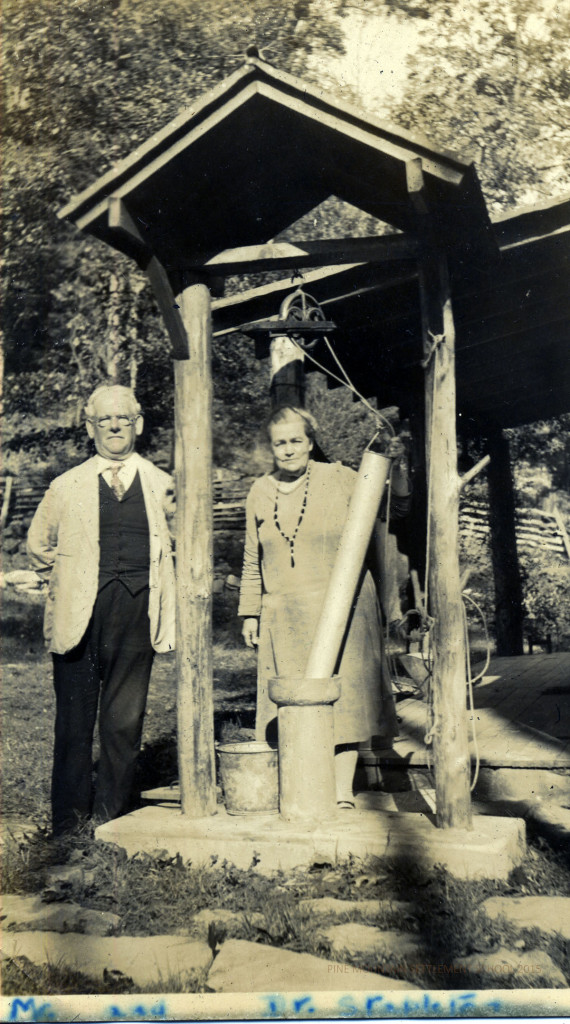
I Angela Melville Album II – Part VI. [Rev. and Dr. Stapleton] [melv_II_album_298.jpg]
In the two years after Miss Medcalf went, the two district schools returned to local influence being very badly taught by a succession of badly prepared teachers, and there was somewhat of a struggle on the part of the workers at the Cabin to do effective work in the neighborhood. Its doors were always open to the neighbors, and some district visiting went on, but by the time Mr. and Mrs. Stapleton [Dr. Ida Stapleton and Rev. Robert Stapleton] arrived to take
charge in 1926, Line Fork had discovered its limitations and had settled down to a less ambitious program. The letters written by the Stapletons every month, on file in Miss Pettit’s accounts of Line Fork, are full of detail as illuminating of conditions for that section, as Miss Elizabeth Smith‘s and Miss Anne Ruth Medcalf‘s rather more sociological studies of the neighborhood.
It has been found so hard by Pine Mountain to get the right type of worker to live in an extension center, and to raise funds for its upkeep, that the ideal we had in 1918, “Five Centers in ten years,” has not come to pass, though people on Cutshin have asked for workers, and Mr. William Creech has offered us his property on Gabes Branch.
SEE ALSO:
EVELYN K. WELLS Biography
MEDICAL SETTLEMENT AT BIG LAUREL

